Comprehensive Report on Management Principles and Techniques
VerifiedAdded on 2023/06/10
|8
|1671
|292
Report
AI Summary
This report provides a detailed overview of management principles, focusing on the four key functions of management: planning, organizing, leading, and controlling, elaborating on their significance in achieving organizational effectiveness. It outlines five planning tools and techniques, including forecasting, contingency planning, scenario planning, benchmarking, and the use of staff planners, highlighting their roles in strategic decision-making. The strategic management process is explained step-by-step, from environmental scanning and strategy formulation to implementation and evaluation. Furthermore, the report differentiates between the general and specific environments, emphasizing their respective impacts on business organizations and competitive advantages. Desklib offers students access to this insightful report along with a variety of past papers and solved assignments.
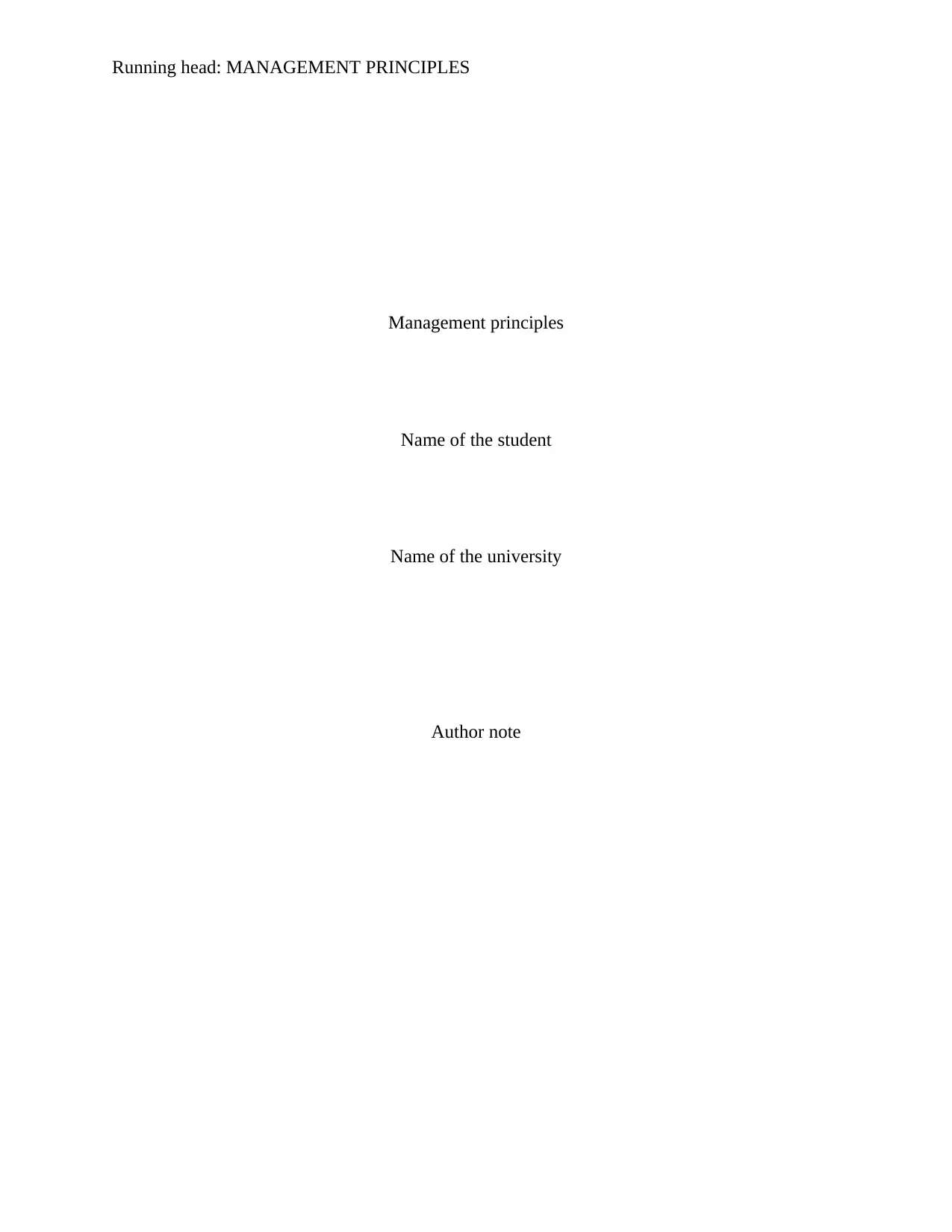
Running head: MANAGEMENT PRINCIPLES
Management principles
Name of the student
Name of the university
Author note
Management principles
Name of the student
Name of the university
Author note
Paraphrase This Document
Need a fresh take? Get an instant paraphrase of this document with our AI Paraphraser
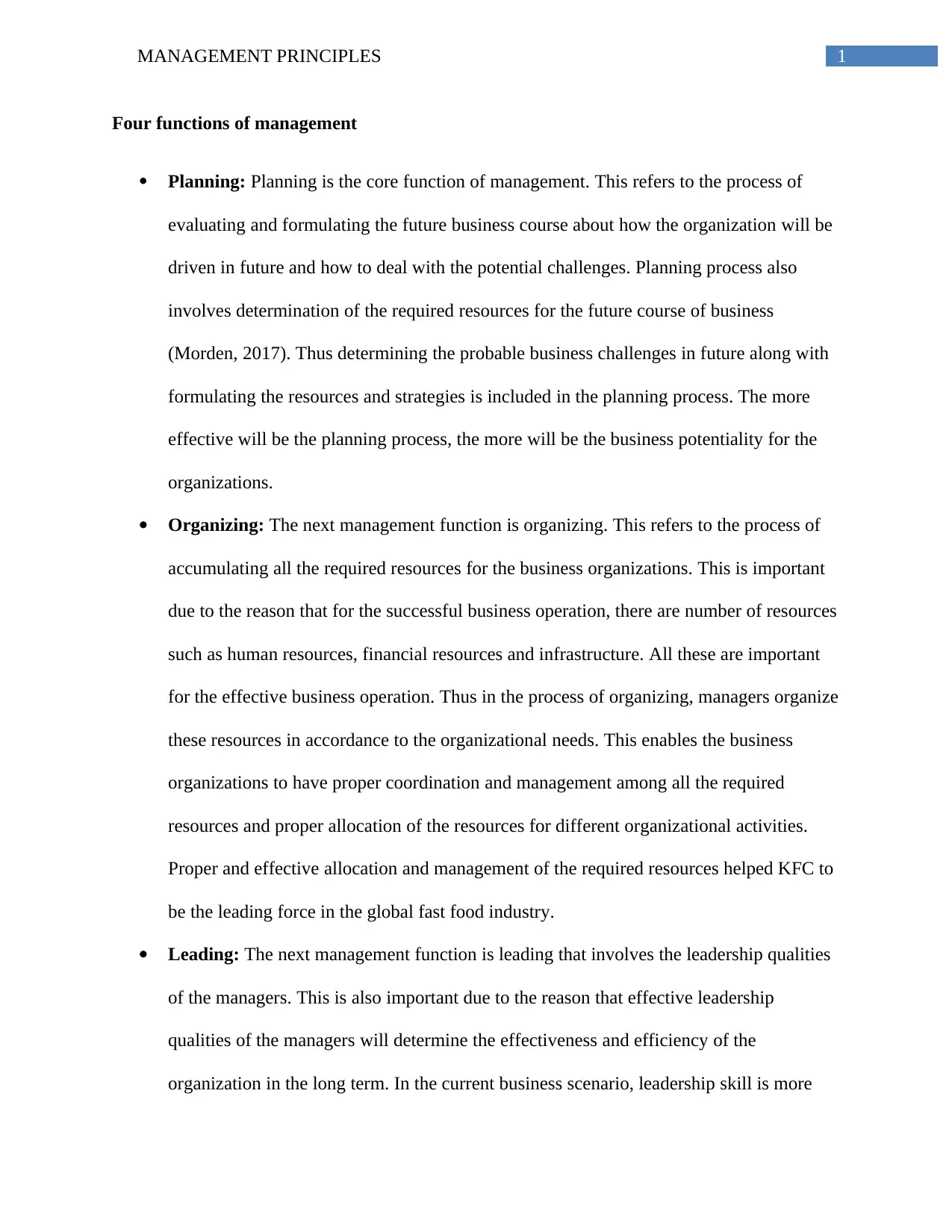
1MANAGEMENT PRINCIPLES
Four functions of management
Planning: Planning is the core function of management. This refers to the process of
evaluating and formulating the future business course about how the organization will be
driven in future and how to deal with the potential challenges. Planning process also
involves determination of the required resources for the future course of business
(Morden, 2017). Thus determining the probable business challenges in future along with
formulating the resources and strategies is included in the planning process. The more
effective will be the planning process, the more will be the business potentiality for the
organizations.
Organizing: The next management function is organizing. This refers to the process of
accumulating all the required resources for the business organizations. This is important
due to the reason that for the successful business operation, there are number of resources
such as human resources, financial resources and infrastructure. All these are important
for the effective business operation. Thus in the process of organizing, managers organize
these resources in accordance to the organizational needs. This enables the business
organizations to have proper coordination and management among all the required
resources and proper allocation of the resources for different organizational activities.
Proper and effective allocation and management of the required resources helped KFC to
be the leading force in the global fast food industry.
Leading: The next management function is leading that involves the leadership qualities
of the managers. This is also important due to the reason that effective leadership
qualities of the managers will determine the effectiveness and efficiency of the
organization in the long term. In the current business scenario, leadership skill is more
Four functions of management
Planning: Planning is the core function of management. This refers to the process of
evaluating and formulating the future business course about how the organization will be
driven in future and how to deal with the potential challenges. Planning process also
involves determination of the required resources for the future course of business
(Morden, 2017). Thus determining the probable business challenges in future along with
formulating the resources and strategies is included in the planning process. The more
effective will be the planning process, the more will be the business potentiality for the
organizations.
Organizing: The next management function is organizing. This refers to the process of
accumulating all the required resources for the business organizations. This is important
due to the reason that for the successful business operation, there are number of resources
such as human resources, financial resources and infrastructure. All these are important
for the effective business operation. Thus in the process of organizing, managers organize
these resources in accordance to the organizational needs. This enables the business
organizations to have proper coordination and management among all the required
resources and proper allocation of the resources for different organizational activities.
Proper and effective allocation and management of the required resources helped KFC to
be the leading force in the global fast food industry.
Leading: The next management function is leading that involves the leadership qualities
of the managers. This is also important due to the reason that effective leadership
qualities of the managers will determine the effectiveness and efficiency of the
organization in the long term. In the current business scenario, leadership skill is more
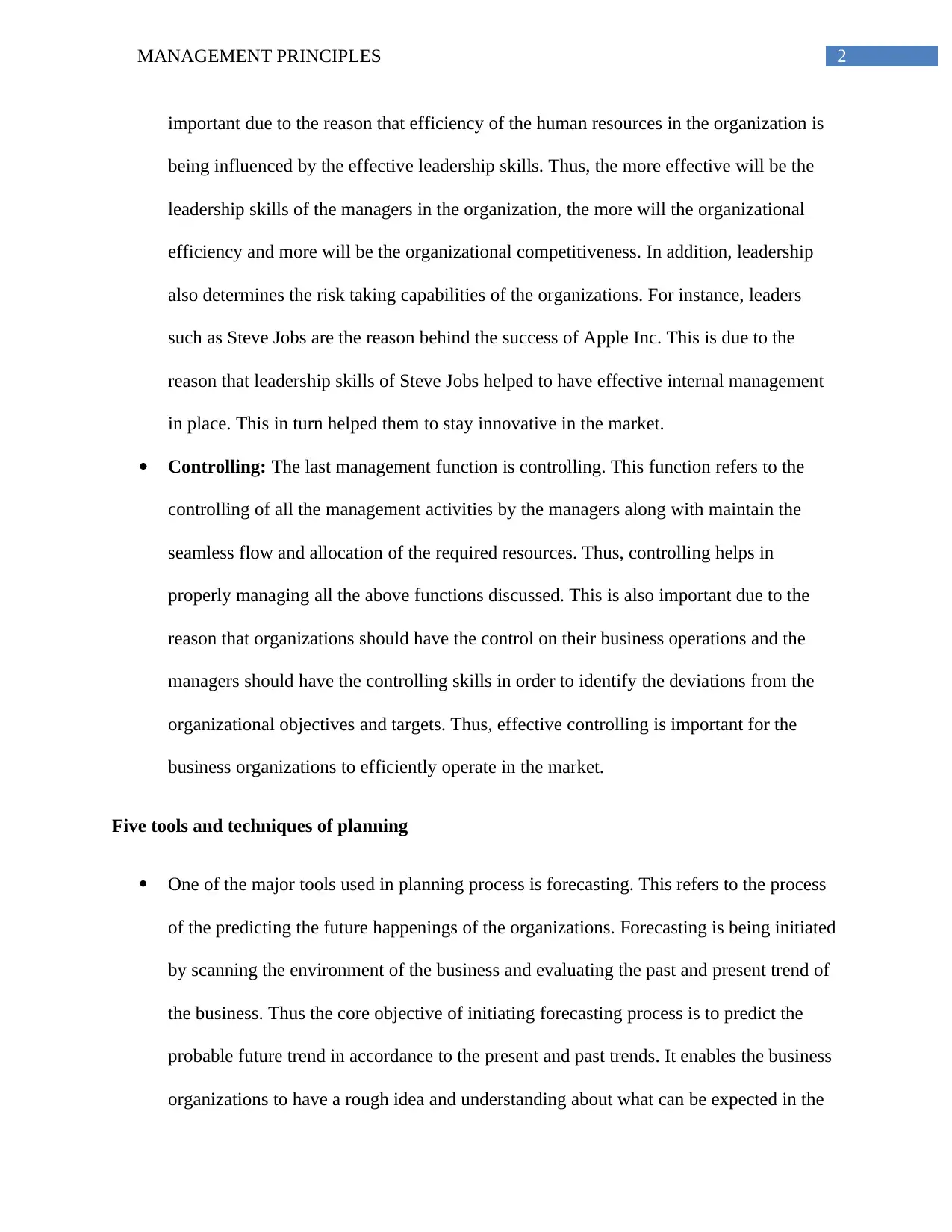
2MANAGEMENT PRINCIPLES
important due to the reason that efficiency of the human resources in the organization is
being influenced by the effective leadership skills. Thus, the more effective will be the
leadership skills of the managers in the organization, the more will the organizational
efficiency and more will be the organizational competitiveness. In addition, leadership
also determines the risk taking capabilities of the organizations. For instance, leaders
such as Steve Jobs are the reason behind the success of Apple Inc. This is due to the
reason that leadership skills of Steve Jobs helped to have effective internal management
in place. This in turn helped them to stay innovative in the market.
Controlling: The last management function is controlling. This function refers to the
controlling of all the management activities by the managers along with maintain the
seamless flow and allocation of the required resources. Thus, controlling helps in
properly managing all the above functions discussed. This is also important due to the
reason that organizations should have the control on their business operations and the
managers should have the controlling skills in order to identify the deviations from the
organizational objectives and targets. Thus, effective controlling is important for the
business organizations to efficiently operate in the market.
Five tools and techniques of planning
One of the major tools used in planning process is forecasting. This refers to the process
of the predicting the future happenings of the organizations. Forecasting is being initiated
by scanning the environment of the business and evaluating the past and present trend of
the business. Thus the core objective of initiating forecasting process is to predict the
probable future trend in accordance to the present and past trends. It enables the business
organizations to have a rough idea and understanding about what can be expected in the
important due to the reason that efficiency of the human resources in the organization is
being influenced by the effective leadership skills. Thus, the more effective will be the
leadership skills of the managers in the organization, the more will the organizational
efficiency and more will be the organizational competitiveness. In addition, leadership
also determines the risk taking capabilities of the organizations. For instance, leaders
such as Steve Jobs are the reason behind the success of Apple Inc. This is due to the
reason that leadership skills of Steve Jobs helped to have effective internal management
in place. This in turn helped them to stay innovative in the market.
Controlling: The last management function is controlling. This function refers to the
controlling of all the management activities by the managers along with maintain the
seamless flow and allocation of the required resources. Thus, controlling helps in
properly managing all the above functions discussed. This is also important due to the
reason that organizations should have the control on their business operations and the
managers should have the controlling skills in order to identify the deviations from the
organizational objectives and targets. Thus, effective controlling is important for the
business organizations to efficiently operate in the market.
Five tools and techniques of planning
One of the major tools used in planning process is forecasting. This refers to the process
of the predicting the future happenings of the organizations. Forecasting is being initiated
by scanning the environment of the business and evaluating the past and present trend of
the business. Thus the core objective of initiating forecasting process is to predict the
probable future trend in accordance to the present and past trends. It enables the business
organizations to have a rough idea and understanding about what can be expected in the
⊘ This is a preview!⊘
Do you want full access?
Subscribe today to unlock all pages.

Trusted by 1+ million students worldwide
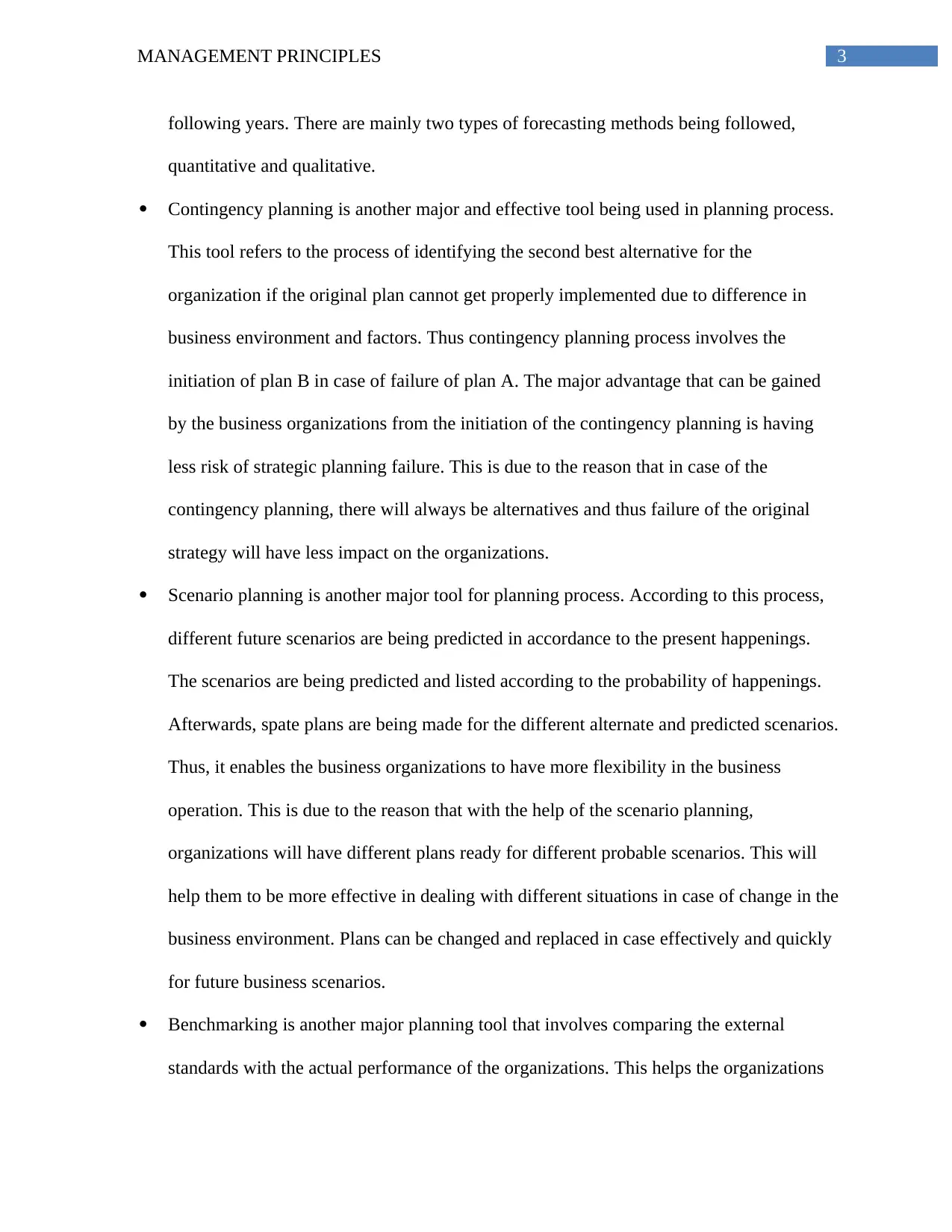
3MANAGEMENT PRINCIPLES
following years. There are mainly two types of forecasting methods being followed,
quantitative and qualitative.
Contingency planning is another major and effective tool being used in planning process.
This tool refers to the process of identifying the second best alternative for the
organization if the original plan cannot get properly implemented due to difference in
business environment and factors. Thus contingency planning process involves the
initiation of plan B in case of failure of plan A. The major advantage that can be gained
by the business organizations from the initiation of the contingency planning is having
less risk of strategic planning failure. This is due to the reason that in case of the
contingency planning, there will always be alternatives and thus failure of the original
strategy will have less impact on the organizations.
Scenario planning is another major tool for planning process. According to this process,
different future scenarios are being predicted in accordance to the present happenings.
The scenarios are being predicted and listed according to the probability of happenings.
Afterwards, spate plans are being made for the different alternate and predicted scenarios.
Thus, it enables the business organizations to have more flexibility in the business
operation. This is due to the reason that with the help of the scenario planning,
organizations will have different plans ready for different probable scenarios. This will
help them to be more effective in dealing with different situations in case of change in the
business environment. Plans can be changed and replaced in case effectively and quickly
for future business scenarios.
Benchmarking is another major planning tool that involves comparing the external
standards with the actual performance of the organizations. This helps the organizations
following years. There are mainly two types of forecasting methods being followed,
quantitative and qualitative.
Contingency planning is another major and effective tool being used in planning process.
This tool refers to the process of identifying the second best alternative for the
organization if the original plan cannot get properly implemented due to difference in
business environment and factors. Thus contingency planning process involves the
initiation of plan B in case of failure of plan A. The major advantage that can be gained
by the business organizations from the initiation of the contingency planning is having
less risk of strategic planning failure. This is due to the reason that in case of the
contingency planning, there will always be alternatives and thus failure of the original
strategy will have less impact on the organizations.
Scenario planning is another major tool for planning process. According to this process,
different future scenarios are being predicted in accordance to the present happenings.
The scenarios are being predicted and listed according to the probability of happenings.
Afterwards, spate plans are being made for the different alternate and predicted scenarios.
Thus, it enables the business organizations to have more flexibility in the business
operation. This is due to the reason that with the help of the scenario planning,
organizations will have different plans ready for different probable scenarios. This will
help them to be more effective in dealing with different situations in case of change in the
business environment. Plans can be changed and replaced in case effectively and quickly
for future business scenarios.
Benchmarking is another major planning tool that involves comparing the external
standards with the actual performance of the organizations. This helps the organizations
Paraphrase This Document
Need a fresh take? Get an instant paraphrase of this document with our AI Paraphraser
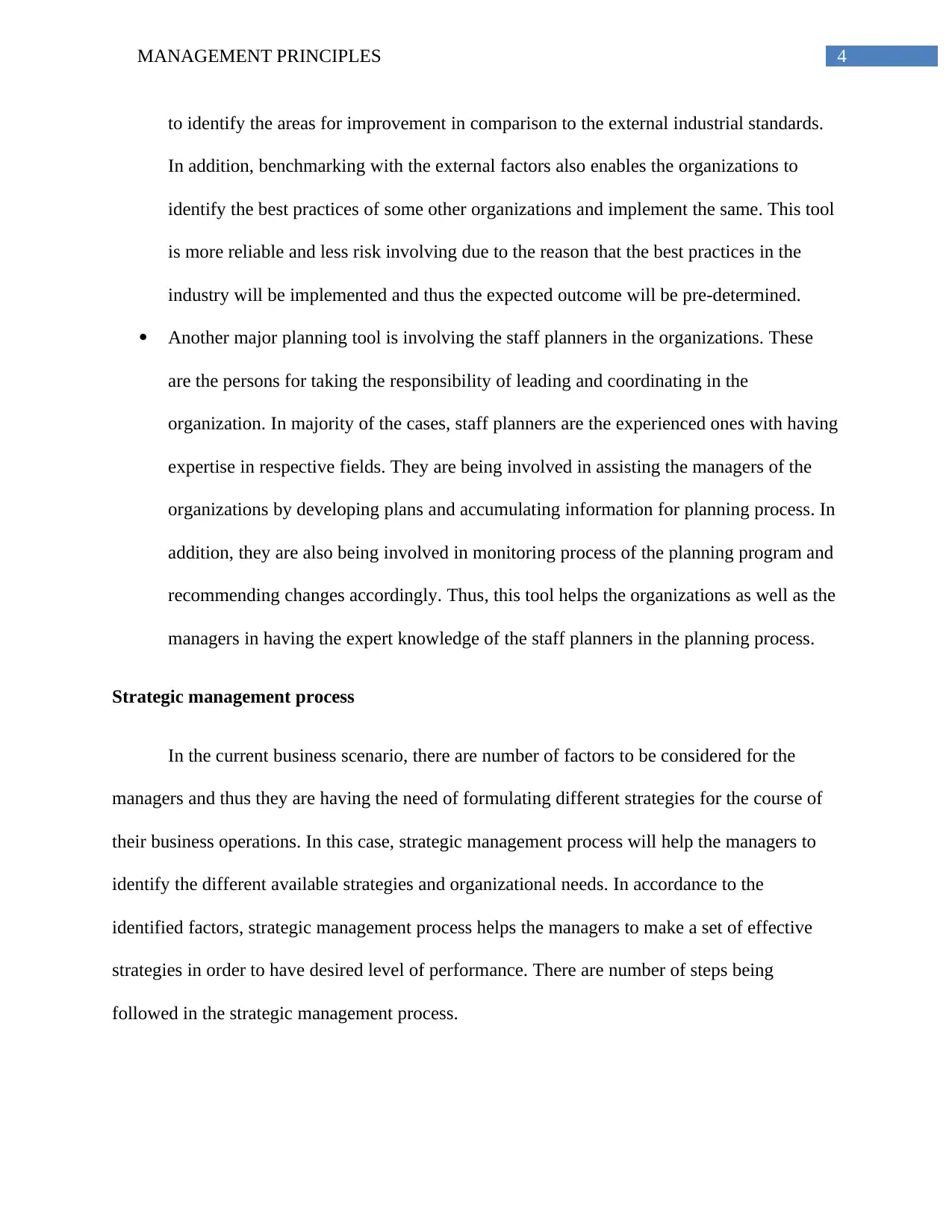
4MANAGEMENT PRINCIPLES
to identify the areas for improvement in comparison to the external industrial standards.
In addition, benchmarking with the external factors also enables the organizations to
identify the best practices of some other organizations and implement the same. This tool
is more reliable and less risk involving due to the reason that the best practices in the
industry will be implemented and thus the expected outcome will be pre-determined.
Another major planning tool is involving the staff planners in the organizations. These
are the persons for taking the responsibility of leading and coordinating in the
organization. In majority of the cases, staff planners are the experienced ones with having
expertise in respective fields. They are being involved in assisting the managers of the
organizations by developing plans and accumulating information for planning process. In
addition, they are also being involved in monitoring process of the planning program and
recommending changes accordingly. Thus, this tool helps the organizations as well as the
managers in having the expert knowledge of the staff planners in the planning process.
Strategic management process
In the current business scenario, there are number of factors to be considered for the
managers and thus they are having the need of formulating different strategies for the course of
their business operations. In this case, strategic management process will help the managers to
identify the different available strategies and organizational needs. In accordance to the
identified factors, strategic management process helps the managers to make a set of effective
strategies in order to have desired level of performance. There are number of steps being
followed in the strategic management process.
to identify the areas for improvement in comparison to the external industrial standards.
In addition, benchmarking with the external factors also enables the organizations to
identify the best practices of some other organizations and implement the same. This tool
is more reliable and less risk involving due to the reason that the best practices in the
industry will be implemented and thus the expected outcome will be pre-determined.
Another major planning tool is involving the staff planners in the organizations. These
are the persons for taking the responsibility of leading and coordinating in the
organization. In majority of the cases, staff planners are the experienced ones with having
expertise in respective fields. They are being involved in assisting the managers of the
organizations by developing plans and accumulating information for planning process. In
addition, they are also being involved in monitoring process of the planning program and
recommending changes accordingly. Thus, this tool helps the organizations as well as the
managers in having the expert knowledge of the staff planners in the planning process.
Strategic management process
In the current business scenario, there are number of factors to be considered for the
managers and thus they are having the need of formulating different strategies for the course of
their business operations. In this case, strategic management process will help the managers to
identify the different available strategies and organizational needs. In accordance to the
identified factors, strategic management process helps the managers to make a set of effective
strategies in order to have desired level of performance. There are number of steps being
followed in the strategic management process.
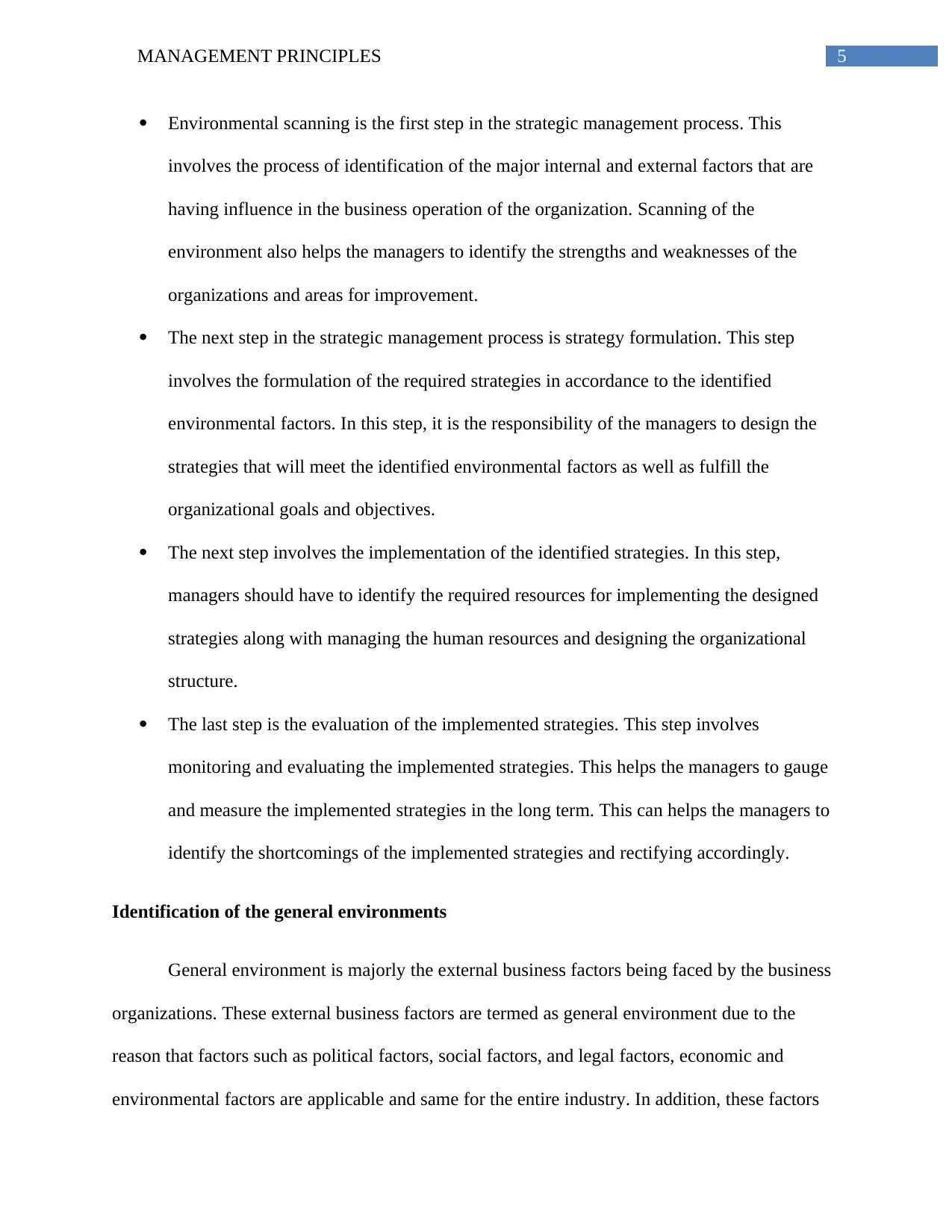
5MANAGEMENT PRINCIPLES
Environmental scanning is the first step in the strategic management process. This
involves the process of identification of the major internal and external factors that are
having influence in the business operation of the organization. Scanning of the
environment also helps the managers to identify the strengths and weaknesses of the
organizations and areas for improvement.
The next step in the strategic management process is strategy formulation. This step
involves the formulation of the required strategies in accordance to the identified
environmental factors. In this step, it is the responsibility of the managers to design the
strategies that will meet the identified environmental factors as well as fulfill the
organizational goals and objectives.
The next step involves the implementation of the identified strategies. In this step,
managers should have to identify the required resources for implementing the designed
strategies along with managing the human resources and designing the organizational
structure.
The last step is the evaluation of the implemented strategies. This step involves
monitoring and evaluating the implemented strategies. This helps the managers to gauge
and measure the implemented strategies in the long term. This can helps the managers to
identify the shortcomings of the implemented strategies and rectifying accordingly.
Identification of the general environments
General environment is majorly the external business factors being faced by the business
organizations. These external business factors are termed as general environment due to the
reason that factors such as political factors, social factors, and legal factors, economic and
environmental factors are applicable and same for the entire industry. In addition, these factors
Environmental scanning is the first step in the strategic management process. This
involves the process of identification of the major internal and external factors that are
having influence in the business operation of the organization. Scanning of the
environment also helps the managers to identify the strengths and weaknesses of the
organizations and areas for improvement.
The next step in the strategic management process is strategy formulation. This step
involves the formulation of the required strategies in accordance to the identified
environmental factors. In this step, it is the responsibility of the managers to design the
strategies that will meet the identified environmental factors as well as fulfill the
organizational goals and objectives.
The next step involves the implementation of the identified strategies. In this step,
managers should have to identify the required resources for implementing the designed
strategies along with managing the human resources and designing the organizational
structure.
The last step is the evaluation of the implemented strategies. This step involves
monitoring and evaluating the implemented strategies. This helps the managers to gauge
and measure the implemented strategies in the long term. This can helps the managers to
identify the shortcomings of the implemented strategies and rectifying accordingly.
Identification of the general environments
General environment is majorly the external business factors being faced by the business
organizations. These external business factors are termed as general environment due to the
reason that factors such as political factors, social factors, and legal factors, economic and
environmental factors are applicable and same for the entire industry. In addition, these factors
⊘ This is a preview!⊘
Do you want full access?
Subscribe today to unlock all pages.

Trusted by 1+ million students worldwide
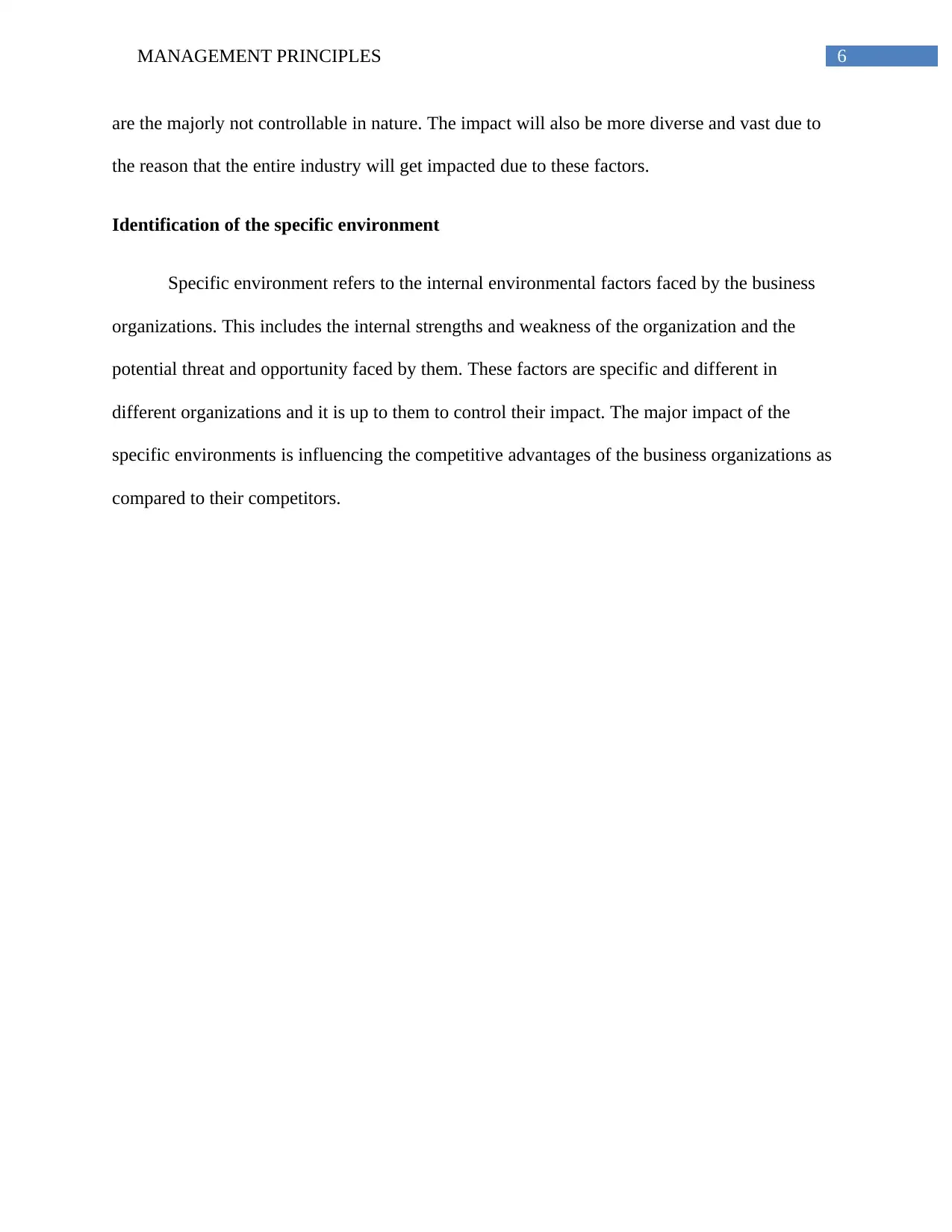
6MANAGEMENT PRINCIPLES
are the majorly not controllable in nature. The impact will also be more diverse and vast due to
the reason that the entire industry will get impacted due to these factors.
Identification of the specific environment
Specific environment refers to the internal environmental factors faced by the business
organizations. This includes the internal strengths and weakness of the organization and the
potential threat and opportunity faced by them. These factors are specific and different in
different organizations and it is up to them to control their impact. The major impact of the
specific environments is influencing the competitive advantages of the business organizations as
compared to their competitors.
are the majorly not controllable in nature. The impact will also be more diverse and vast due to
the reason that the entire industry will get impacted due to these factors.
Identification of the specific environment
Specific environment refers to the internal environmental factors faced by the business
organizations. This includes the internal strengths and weakness of the organization and the
potential threat and opportunity faced by them. These factors are specific and different in
different organizations and it is up to them to control their impact. The major impact of the
specific environments is influencing the competitive advantages of the business organizations as
compared to their competitors.
Paraphrase This Document
Need a fresh take? Get an instant paraphrase of this document with our AI Paraphraser
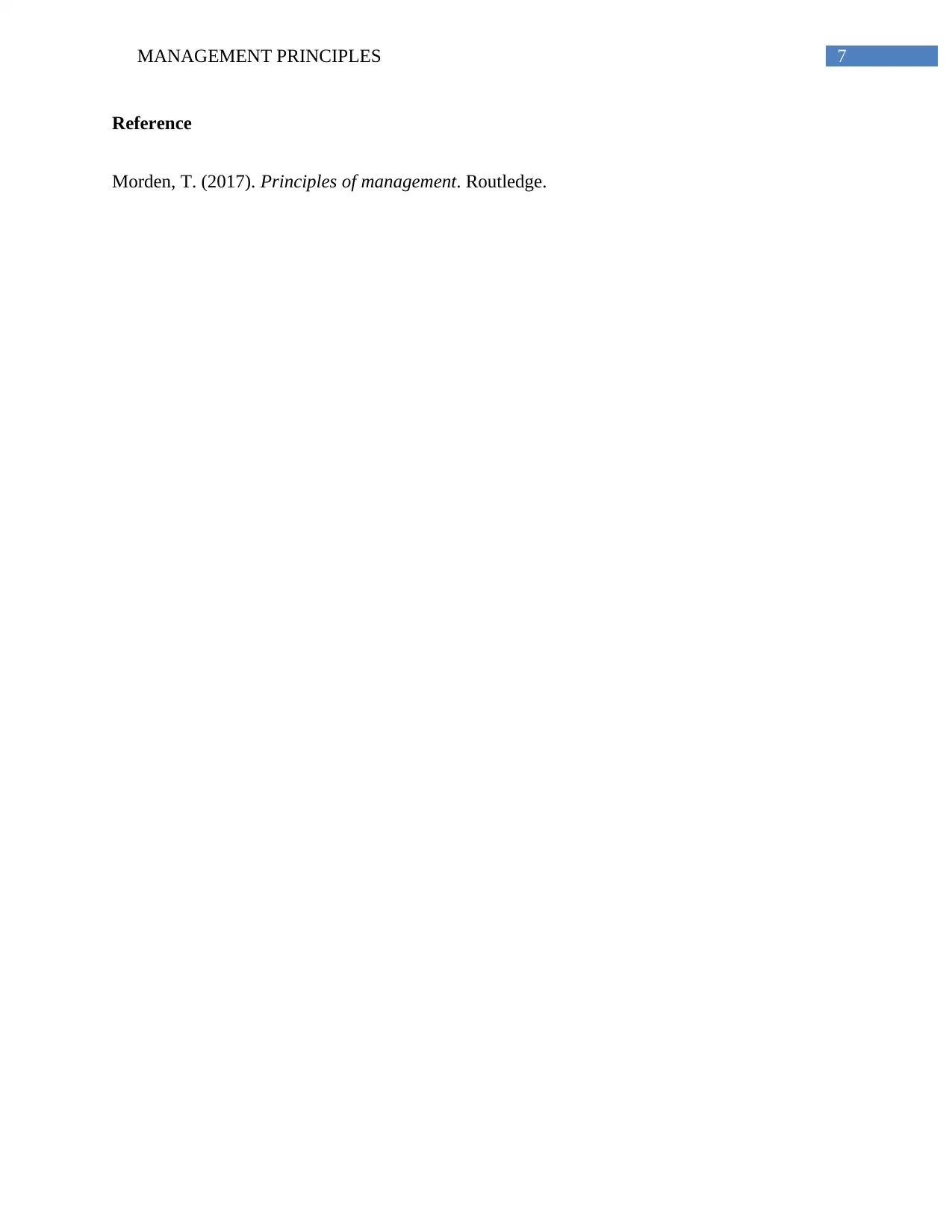
7MANAGEMENT PRINCIPLES
Reference
Morden, T. (2017). Principles of management. Routledge.
Reference
Morden, T. (2017). Principles of management. Routledge.
1 out of 8
Related Documents
Your All-in-One AI-Powered Toolkit for Academic Success.
+13062052269
info@desklib.com
Available 24*7 on WhatsApp / Email
![[object Object]](/_next/static/media/star-bottom.7253800d.svg)
Unlock your academic potential
Copyright © 2020–2025 A2Z Services. All Rights Reserved. Developed and managed by ZUCOL.





